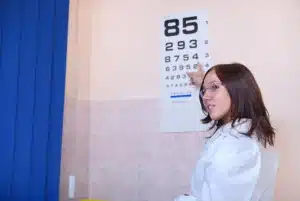Did you know more than 3 of 4 people in the United States – 79% to be exact – wear vision correction lenses of some sort? That accounts for more than 200 million people in the United States who wear either eyeglasses, prescription sunglasses, reading glasses, and/or contact lenses on a daily or regular basis.
Of those 200 million people, more than 60% wear prescription glasses and roughly 20% wear contact lenses. A smaller percentage of those people elect to have laser surgery, though that percentage is growing larger as the technology behind vision correction becomes much more reliable and effective.
Still, glasses and contact lenses continue to be a preferred treatment for refractive errors and are the most prominent and practical alternative to laser surgery. They both have benefits and both have downfalls, but getting a contacts vs glasses prescription is relatively easy and allows you to see clearly.
What Are Refractive Errors?
Before we dive into the differences between a contacts and glasses prescription, let’s first make sure we understand what a refractive error is and how corrective lenses help. In simple terms, a refractive error occurs when the shape of the eye prevents light from focusing on the back of the eye (retina) properly.
There are four primary types of refractive errors, including:
- Nearsightedness – also known as myopia, nearsightedness is when distant objects appear blurry and nearby objects are clear, which is caused by an eyeball that’s too long or oval-shaped.
- Farsightedness – also known as hyperopia, farsightedness is when nearby objects appear blurry and distant objects are clear, which is caused by an eyeball that isn’t curved enough.
- Astigmatism – this occurs when both distant objects and nearby objects appear blurry or distorted, which is caused by abnormal curvature of the lens or cornea.
- Presbyopia – similar to farsightedness (nearby objects appear blurry), but is a natural part of the aging process, is more prevalent in older patients, and is caused by a loss of elasticity of the lens.
Refractive errors are often characterized by blurry vision, hazy vision, double vision, frequent glares, halos around lights, and needing to squint often – they can also result in headaches, eye strain, and difficulty focusing when using a computer or reading a book. Patients have a hard time seeing clearly.
Contacts vs Glasses Prescription
Reading your contact lens or eyeglass prescription is often much easier said than done, but it just takes a vague understanding of what the many numbers and symbols mean. For starters, it’s important to know the difference between the right eye (OD or Oculus Dexter) and left eye (OS or Oculus Sinister).
Each eye will have a different measurement. A ‘+’ sign in front of the number (sphere or curve of the lens) indicates farsightedness, while a ‘-’ sign in front of the number indicates nearsightedness. The further away this number is from zero, the worse your vision is – the number is measured in diopters (or D).
Glasses prescriptions will contain several other measurements – including the Cylinder, Axis, and Pupillary Distance. The Cylinder indicates the power needed to correct astigmatism, the Axis indicates the orientation of the astigmatism, and the Pupillary Distance indicates the distance between both pupils.
A contact lens prescription, on the other hand, requires a different set of variables and specifications:
- Base Curve – this measurement is essential to making sure the contact lens fits snug around the eye and is determined by the shape of the cornea (front surface of the eye).
- Lens Diameter – this measurement indicates the size of the lens as measured to your eye, with soft contacts ranging from 13.5 to 14.5 millimeters, while hard contacts range from 8.5 to 9.5 mm.
- Lens Brand/Lens Material – there are a number of different lens brands, each of which use a different material and offer a different level of oxygen permeability.
- Expiration Date – most contact lens prescriptions expire after a year, at which point a new and updated prescription is needed.
For example, a prescription might look like this: -3.25 DS (nearsightedness), +2.25 DS (farsightedness), or -4.50 -1.50 x 180 (astigmatism) – your doctor will also include measurements to the other variables listed above, but those measurements will depend on whether it’s an eyeglasses or contacts prescription.
Benefits of Contacts vs Glasses
Contact lenses and glasses are both solutions to the same problem, but they present a unique experience for those requiring vision correction. They both have unique pros and cons to consider – including ease of use, maintenance, appearance, irritability, and much more. Don’t worry, we’ll break it all down for you!
Here are some of the pros of eyeglasses:
- Easy to wear
- Easy to clean and store
- They last a long time if cared for properly
- Variety of frames to choose from
- You don’t need to touch your eyes to wear them
- Offer protection from the elements
Here are some of the cons of eyeglasses:
- Entire field of vision isn’t accounted for
- More expensive to replace
- Can be uncomfortable and irritable
- Some people don’t like the look of them
- Easily get fogged up and/or scratched
Here are some of the pros of contact lenses:
- Account for your entire visual field because contact lenses sit directly on the tear film
- More freedom of movement while active
- Wearing contact lenses won’t change your appearance
- Can choose different eye colors
- Can wear non-prescription sunglasses
- Easier and less expensive to replace
Here are some of the cons of contacts prescriptions:
- Wearing contacts is harder to maintain, clean, store, and care for
- Much more difficult to put in and take out of the eye
- Contact lenses require more of a commitment
- Increased risk of damaging the eyes with improper use
- Increased risk of eye strain when using at the computer
Are you in need of vision correction? Do you suffer from a refractive error? Are you having a hard time deciding between glasses and contact lenses? Are you ready to get fitted for contacts or eyeglasses? If you answered ‘yes’ to any of those questions, then contact Milwaukee Eye Surgeons right away!
Dr. Kenneth Weinlander can help you navigate your options and can even help you determine if you’re a quality candidate for LASIK eye surgery. To learn more about refractive errors and whether or not you have one, contact our office at (414) 377-5550 or email us at info@MilwaukeeEyeSurgeons.com.




